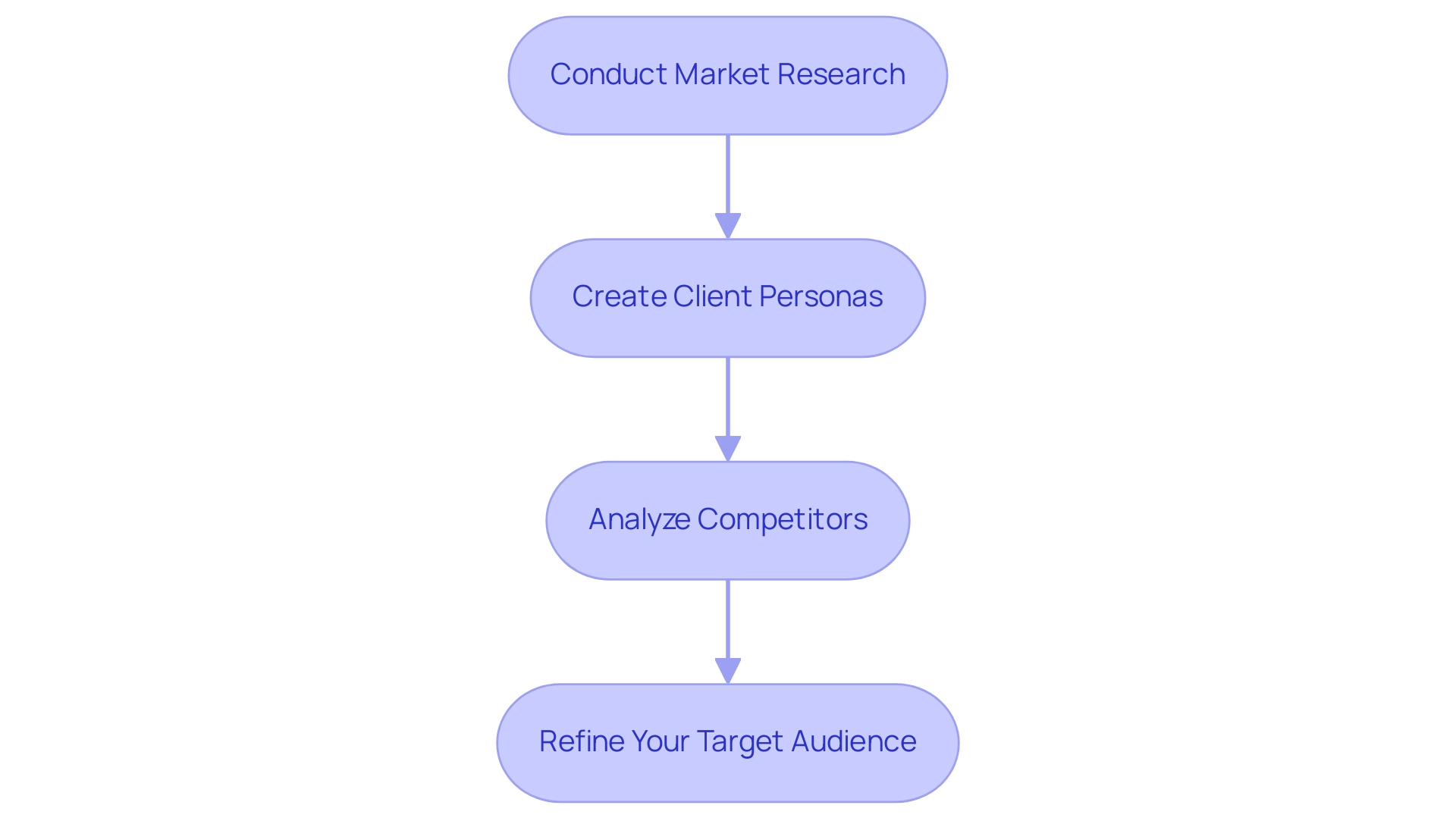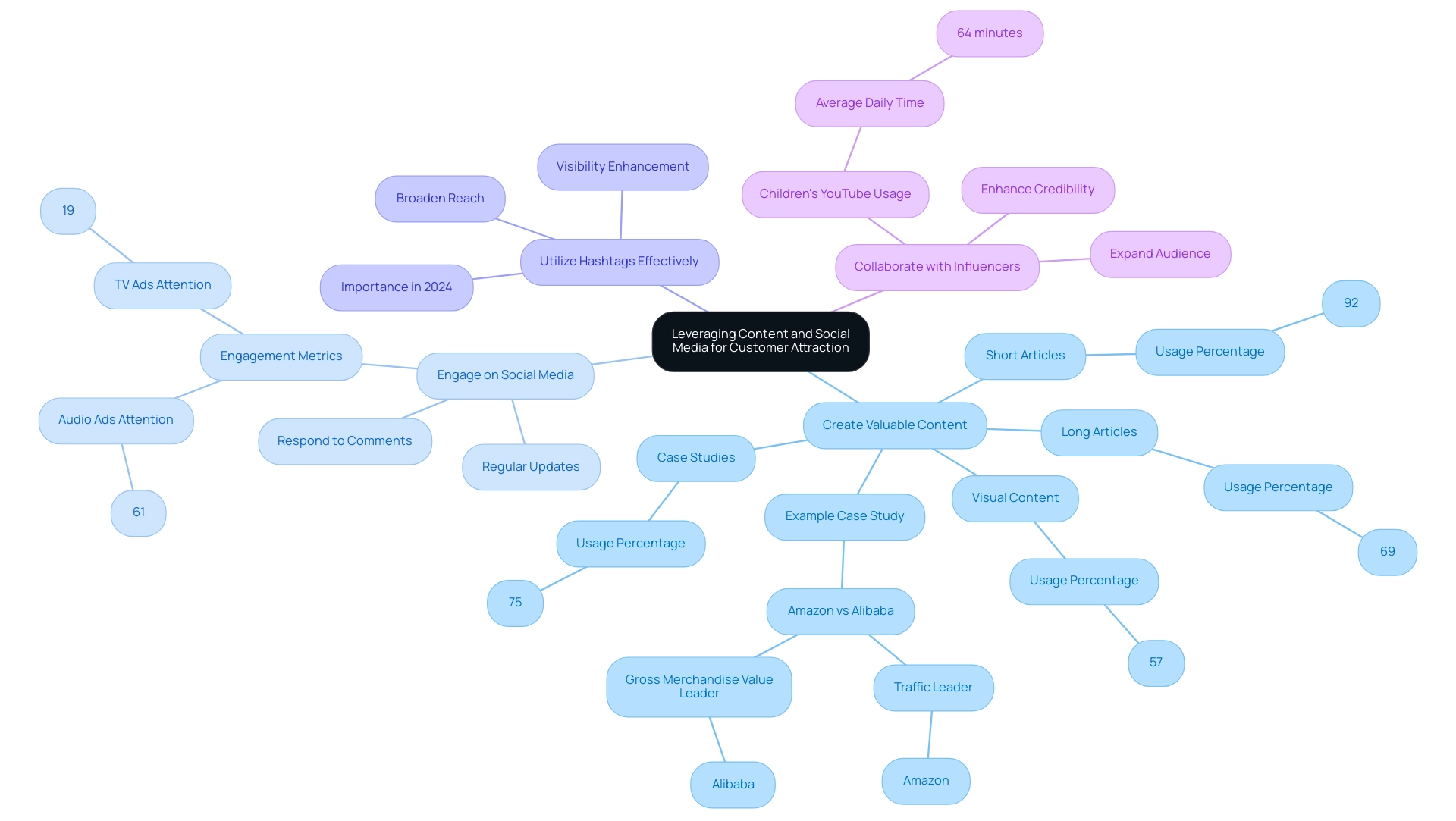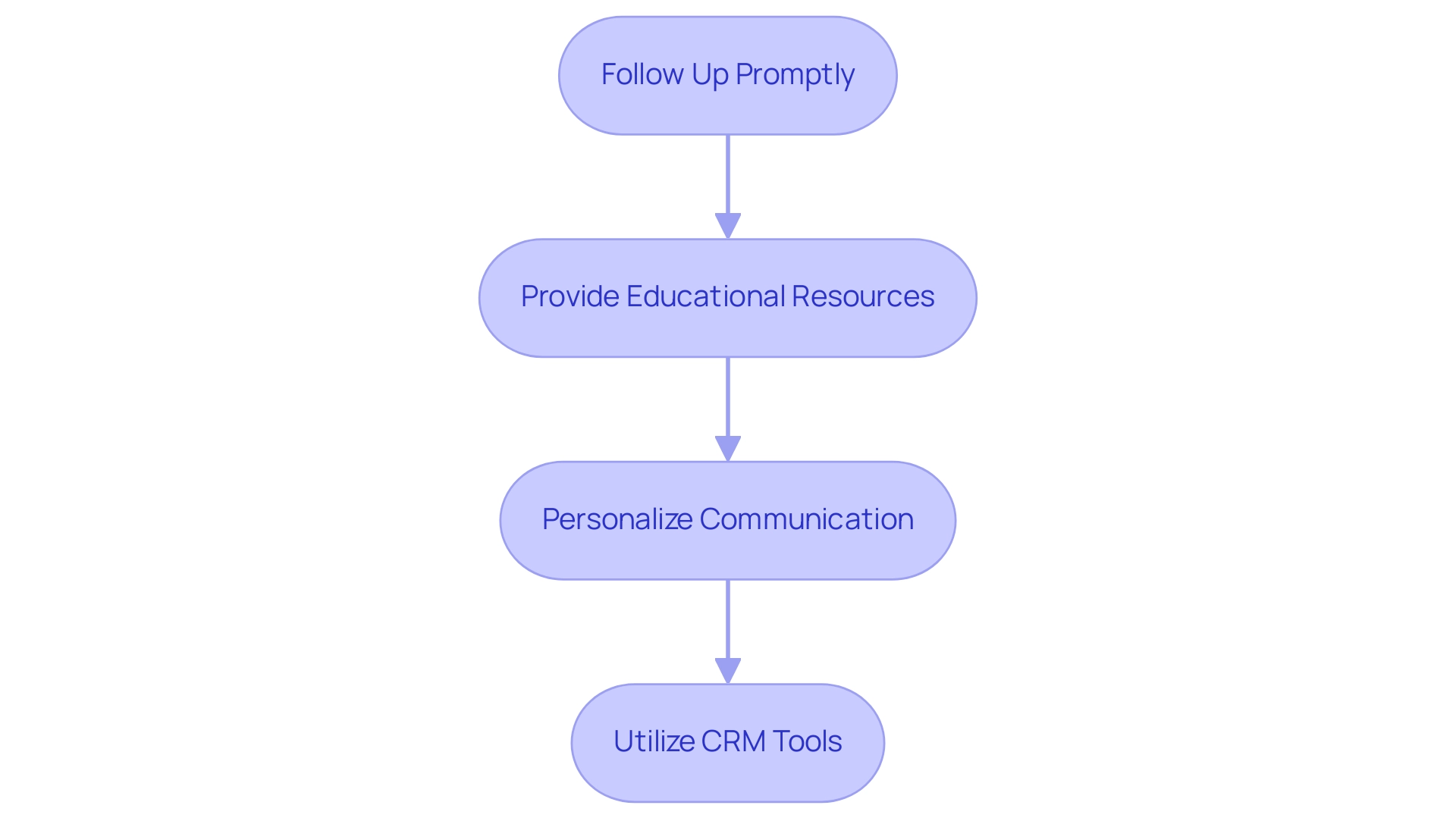Overview
The article serves as a comprehensive guide to attracting your first customers by emphasizing the importance of identifying your ideal customer, implementing effective marketing strategies, and nurturing leads. It supports this by outlining actionable steps such as conducting market research, utilizing SEO and social media, and leveraging customer feedback, all of which are crucial for building trust and enhancing customer engagement.
Introduction
In the competitive landscape of modern business, understanding and connecting with the ideal customer has never been more crucial. As companies navigate through an ever-evolving marketplace, identifying the right audience lays the foundation for successful marketing strategies.
By employing effective market research techniques, crafting detailed customer personas, and analyzing competitors, businesses can position themselves to meet the needs of their target audience. This article delves into the essential steps for recognizing and engaging potential customers, offering practical insights into refining marketing approaches that not only attract but also convert leads into loyal clients.
From leveraging content and social media to nurturing leads through personalized communication, the journey towards building a robust customer base begins with a clear understanding of who the ideal customer truly is.
Identifying Your Ideal Customer: The First Step to Success
- Conduct Market Research: To effectively engage potential clients, start by leveraging various market research methods such as surveys, interviews, and demographic analysis. Recent studies indicate that robust market research methods significantly enhance the ability to identify and understand your target audience in 2024. Notably, 61% of audio listeners pay attention to audio ads, compared to just 19% of TV watchers who actively watch TV ads, highlighting the effectiveness of targeted advertising methods in market research. As a crucial first step, this research will inform your strategy by revealing valuable insights about consumer behaviors and preferences.
- Create Client Personas: Once you have gathered sufficient data, the next step is to create detailed client personas. These profiles should encompass key demographics, interests, and pain points of your ideal clients. This approach allows you to customize your promotional strategies more effectively. Successful businesses have utilized consumer personas to clarify their messaging and enhance engagement, reinforcing the need for precise targeting in your marketing efforts.
- Analyze Competitors: Understanding your competitors is essential in identifying potential market gaps. By studying who they target and how they position themselves, you can uncover opportunities for differentiation. For instance, Amazon leads in e-commerce traffic, while Alibaba’s Taobao and Tmall dominate in gross merchandise value. This case study demonstrates how examining market leaders can serve as a guide to attracting your first customers and help identify unmet demands that your offerings could address.
- Refine Your Target Audience: Market research is not a one-time effort; it requires ongoing refinement. Continuously gather feedback and analyze data to adjust your client profiles. This iterative process ensures that your promotional approaches remain aligned with evolving customer preferences, ultimately enhancing your ability to attract and retain your ideal clientele.

Effective Marketing Strategies: From Attraction to Conversion
- Creating a strong promotional plan serves as a guide to attracting your first customers and is the foundation of any successful business approach. Start by outlining your specific goals, identifying your target audience, and detailing the methods you will employ to reach them. This plan serves as a roadmap and a guide to attracting your first customers, focusing your efforts in a clear direction.
-
Utilize SEO Techniques: In today’s digital landscape, optimizing your website and content for search engines is essential for increasing visibility. Recent statistics reveal that businesses employing effective SEO techniques see significant growth in website traffic and engagement. Expert opinions indicate that with the appropriate SEO approaches, even small businesses can compete in saturated markets.
-
Invest in Paid Advertising: With platforms like TikTok generating an impressive $4 billion in advertising revenue in 2022—projected to double by 2024—consider investing in paid advertising. Google Ads and targeted social media ads can help you reach a broader audience quickly. Given that 61% of audio listeners pay attention to audio ads, diversifying your ad formats can also enhance your reach. Additionally, with children in the UK spending an average of 64 minutes daily on YouTube, incorporating video promotion into your strategy can effectively engage younger audiences.
-
Utilize Email Promotion: Email promotion remains one of the most effective channels for nurturing prospects and encouraging conversions. By crafting focused email campaigns that connect with your audience’s interests and needs, you can build a devoted clientele. Remember, adaptability is crucial; with 44% of leads generated outside conventional business hours, having a flexible approach to your marketing efforts will ensure you’re capturing potential clients at all times. This emphasizes the importance of modifying your approaches to satisfy client requirements whenever they occur.

Leveraging Content and Social Media for Customer Attraction
-
Create Valuable Content: Focus on producing high-quality blog posts, engaging videos, and informative infographics that resonate with the needs and interests of your target audience. Notably, 43% of marketers cite the creation of consistently high-quality visual content as one of their greatest challenges. By overcoming this hurdle, you not only attract attention but also build trust. B2B marketers have shown a preference for diverse content types, with:
- 92% utilizing short articles
- 69% using long articles
- 75% leveraging case studies
- 57% focusing on visual content
These formats serve as a guide to attracting your first customers and establishing your authority in the market. For instance, the case study of Amazon and Alibaba illustrates how different content marketing approaches can lead to varying strengths in e-commerce, highlighting the importance of tailored content.
-
Engage on Social Media: Make it a priority to regularly post updates and respond to comments. Building a community around your brand is essential; using a guide to attracting your first customers can significantly improve customer loyalty through active engagement. According to recent studies, 61% of audio listeners pay attention to audio ads, a stark contrast to the mere 19% of TV watchers who actively engage with TV ads. This emphasizes the necessity of creating engaging content tailored to the platform you are using, particularly in social media where audio content can enhance engagement.
-
Utilize Hashtags Effectively: Research and apply relevant hashtags to broaden your post’s reach. Hashtags can significantly enhance visibility and connect you with a wider audience. In 2024, effective hashtag strategies are more important than ever as businesses seek to stand out in crowded feeds.
-
Collaborate with Influencers: Partnering with influencers in your niche can expand your audience and enhance your credibility. Influencer marketing remains a powerful tool, especially as children in the UK spend an average of 64 minutes daily on platforms like YouTube. Leveraging these trends can act as a guide to attracting your first customers by helping you tap into new customer segments and create meaningful connections.

Nurturing Leads: Turning Interest into Commitment
-
Follow Up Promptly: It’s critical to connect with your prospects within 24 hours. This quick response not only demonstrates your enthusiasm but also helps maintain their interest. Experts recommend that the optimal number of follow-ups in a cold email outreach sequence should be between two and four, with the first follow-up being essential for increasing the likelihood of a response. Significantly, research shows that timely text message follow-ups can result in an impressive 112.6% increase in converting contacts into engaged prospects, underscoring the importance of prompt follow-up strategies.
Provide Educational Resources: Sharing relevant educational materials—such as articles, webinars, or a guide to Attracting your first customers—can significantly address your prospects’ needs and concerns. This approach not only positions you as a knowledgeable resource but also acts as a guide to attracting your first customers by providing them with valuable insights. Alla Ivanova, the Head of SDR at Belkins, emphasizes the importance of crafting messages that resonate:
The frequency of follow-ups is determined by the topic relevance and the capability to organically craft the messages without being annoying.
-
Personalize Communication: Tailoring your messages based on the prospect’s interests and previous interactions is vital in fostering a connection. Personalization not only enhances engagement but also demonstrates your commitment to understanding their unique challenges. Considering that monitoring responses—both positive and negative—is crucial for enhancing your email content, this approach guarantees that your outreach stays pertinent and efficient.
Utilize CRM Tools: Implementing Customer Relationship Management (CRM) tools is essential for tracking interactions and managing follow-ups efficiently. These tools can assist you in organizing your outreach efforts, monitoring engagement levels, and scheduling timely follow-ups, ultimately enhancing your overall lead nurturing approach. Significantly, sales professionals frequently encounter challenges such as lack of time (27%), insufficient resources (23%), and weak client relationships (21%). By addressing these challenges through effective management tools, you can streamline your processes and enhance your follow-up strategies.

Building Trust: The Power of Customer Feedback and Reviews
- Encourage Reviews: Actively request pleased clients to share their experiences on your website and social media platforms. With 88% of all business reviews originating from just five well-known sources, it’s essential to position your brand where prospective clients are searching. As noted by Simon-Kucher,
> 33% have switched brands due to consumer ratings <, highlighting the transformative power of positive feedback. By evaluating and analyzing these online ratings, companies can develop better offers and increase their willingness to pay. - Showcase Testimonials: Prominently display positive reviews on your website and promotional materials. Effective showcasing not only builds credibility but also acts as a guide to attracting your first customers. Current trends indicate that testimonials play a vital role in influencing purchase decisions, especially when consumers engage in thorough research—75% actively search for reviews before committing to a purchase. This highlights the significance of incorporating client feedback into your guide to attracting your first customers.
- Respond to Feedback: Engage meaningfully with both positive and negative reviews. This illustrates your dedication to client satisfaction and can assist in reducing any possible harm from negative feedback. Companies that actively respond to reviews can foster a sense of trust and reliability, which is essential in today’s competitive landscape.
- Utilize Case Studies: Share detailed case studies that exemplify how your product or service has made a positive impact on clients. By illustrating real-life applications and outcomes, you can effectively communicate value. Research habits indicate that 80% of consumers compare prices and 67% visit brand websites, making it essential for businesses to utilize testimonials and case studies to enhance their marketing efforts. Notably, implementing tools like TrustPulse, which notify visitors of recent purchases, can boost sales by up to 15%. By integrating such tools into your strategy for showcasing customer success stories, you can create a more compelling narrative that resonates with potential buyers.

Conclusion
Understanding and engaging with the ideal customer is paramount for success in today’s competitive business environment. The journey begins with thorough market research, which provides invaluable insights into customer behaviors and preferences. Creating detailed customer personas allows for tailored marketing strategies that resonate with the target audience, while competitor analysis helps identify market gaps and opportunities for differentiation.
As businesses refine their marketing plans, leveraging SEO techniques and investing in paid advertising can significantly improve visibility and reach. Utilizing content and social media effectively not only attracts potential customers but also builds a loyal community around the brand. Engaging with customers through valuable content and active social media presence enhances trust and credibility.
Nurturing leads into loyal customers requires prompt follow-up, personalized communication, and the use of CRM tools to manage interactions efficiently. Additionally, building trust through customer feedback, reviews, and testimonials is essential for influencing purchase decisions and maintaining a positive brand image.
In essence, the key to a successful marketing strategy lies in a deep understanding of the ideal customer and continuous adaptation to their needs. By implementing these strategies, businesses can not only attract but also convert leads into lasting relationships, driving growth and ensuring long-term success in an ever-evolving marketplace.


